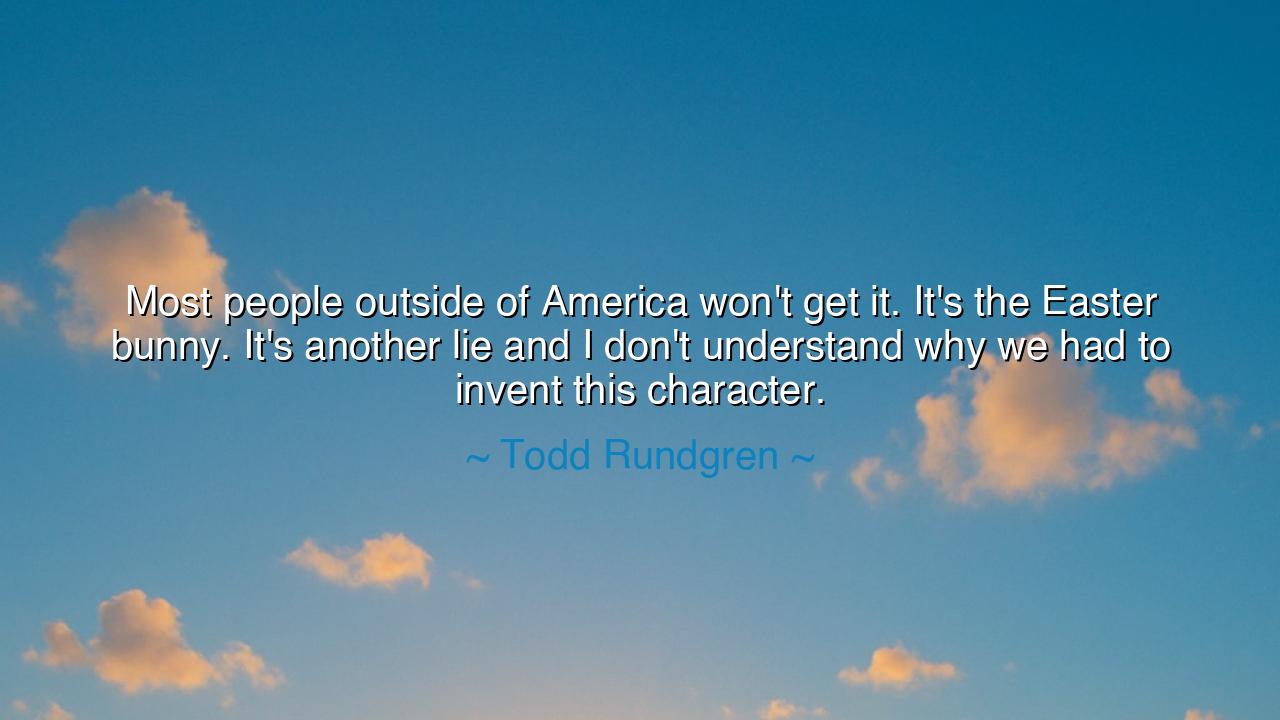
Most people outside of America won't get it. It's the Easter
Most people outside of America won't get it. It's the Easter bunny. It's another lie and I don't understand why we had to invent this character.






In the questioning words of Todd Rundgren, the artist and philosopher of sound, there resounds a cry that pierces through the illusions of comfort and tradition: “Most people outside of America won’t get it. It’s the Easter Bunny. It’s another lie and I don’t understand why we had to invent this character.” At first, it seems a jest — a complaint against a harmless symbol of springtime and festivity. But beneath the humor lies a deeper unease, a challenge to the falsehoods we weave into the hearts of children and into the very fabric of our culture. Rundgren, ever the provocateur, speaks here not against the Easter Bunny itself, but against the human tendency to create illusions to fill the void of understanding — to substitute myth for meaning when the truth feels too heavy or too distant to bear.
To understand the origin of this thought, one must look to Rundgren himself — a man whose art, like his words, has always sought authenticity in a world addicted to appearances. As a musician, he stood apart from the commercial tides of his time, refusing to mold his soul to the expectations of industry. In speaking of the Easter Bunny, he is not merely mocking a holiday custom; he is questioning the cultural habit of deception — the little lies told in good faith, which often grow into great lies told for convenience. To him, the Easter Bunny is a symbol of society’s willingness to trade truth for spectacle, substance for sentiment, and reality for the comfortable dream of make-believe.
But there is an ancient rhythm to this dilemma. From the dawn of civilization, mankind has cloaked its mysteries in myth. The Greeks imagined gods upon Olympus, weaving their fates with divine hands; the Norse told of Yggdrasil, the tree that bound all worlds; and even in the early Christian world, ancient spring rites were merged with new faiths to give birth to what we now call Easter — a celebration of resurrection and renewal, wrapped in the symbols of fertility: eggs, rabbits, and rebirth. The Easter Bunny, then, is not born of malice but of longing — the longing of humanity to make the invisible visible, to give the ineffable a face. It is the same longing that built temples, painted icons, and told bedtime tales: the desire to touch what cannot be touched.
Yet Rundgren’s lament strikes at the shadow of this beauty — the corruption of myth into illusion. For there is a difference between stories that awaken the spirit and fables that lull it to sleep. In his words, “another lie” is not merely a falsehood told to children, but a reflection of a larger spiritual malaise — that we, as a culture, have forgotten how to seek meaning beyond our inventions. Like the Easter Bunny, many of our modern myths no longer point toward transcendence; they serve instead to distract us from the truth of life’s fragility and wonder. We trade the mystery of resurrection for a basket of chocolate eggs, the holiness of renewal for a commercial holiday. Rundgren’s frustration is not with innocence, but with artifice — with the way we have replaced revelation with entertainment.
History, too, warns us of this danger. The Roman poet Juvenal once spoke bitterly of “bread and circuses” — the shallow pleasures that numbed the citizens of Rome while their empire decayed from within. The rulers, he said, learned that if they gave the people distractions, they would not seek justice or truth. Rundgren’s words echo that ancient warning. The Easter Bunny, in its harmless form, may seem innocent — yet it represents something larger: our growing dependence on illusion to make sense of the world. We invent comfort to escape complexity, forgetting that wisdom is born not from fantasy, but from awakening.
But there is another layer still — a tenderness hidden beneath the skepticism. Rundgren is not calling for cynicism; he is calling for clarity. He asks why we must invent falsehoods to express beauty, when truth itself is wondrous enough. Why must we teach children to believe in a rabbit that hides eggs, when we could instead teach them to marvel at the real miracle — the returning of the sun, the blooming of the earth, the mystery of life reborn each spring? The true “resurrection” is not in mythic creatures but in the awakening of awareness — the moment a child sees the world as it is, and finds it still sacred.
The lesson of Rundgren’s words is not to abandon wonder, but to purify it. Let us keep our stories, but let them be rooted in truth — let them serve as windows, not walls. Teach the young to see joy in reality itself: the warmth of sunlight, the greening of the trees, the courage of renewal that lives in every seed. For wonder does not need disguise; it blooms naturally in hearts that seek truth. The world does not need another invented character to be beautiful — it needs eyes that can still see the beauty that already is.
So let us take Rundgren’s questioning as both challenge and blessing. Let us strip away the illusions that dull our spirits and rediscover the sacred in the real. For though myths may fade and symbols may change, the essence of truth remains eternal — that life renews itself, that light returns after darkness, and that the simplest truths, once seen clearly, are more miraculous than any fable. The Easter Bunny may be a lie, but the resurrection of wonder — that, my friends, is forever true.






AAdministratorAdministrator
Welcome, honored guests. Please leave a comment, we will respond soon